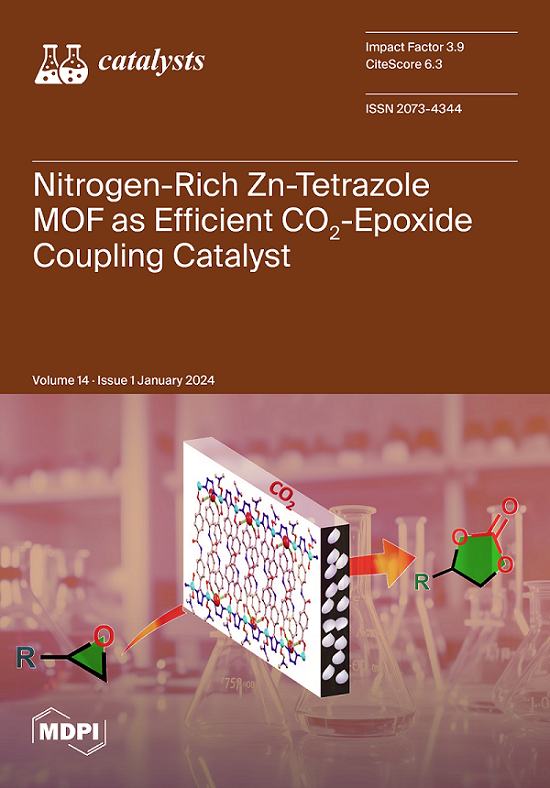硫酸改性生物炭催化剂支撑的镍纳米颗粒上糠醛加氢生成 2-甲基呋喃的动力学模型
IF 4
3区 化学
Q2 CHEMISTRY, PHYSICAL
引用次数: 0
摘要
木质纤维素生物质可在生长过程中吸收二氧化碳,然后热解成三种主要产品:生物炭(BC)、合成气和生物油。由于含氧有机化合物的存在,生成的生物油不适合直接用作燃料,需要通过氢脱氧(HDO)和氢化进行提纯。这通常是在支撑金属催化剂上进行的。在循环经济和可持续发展方面,热解步骤产生的 BC 有可能被活化并用作新型催化剂载体,正如本文所报道的那样。通过用硫酸对 BC 进行化学改性以改善介孔结构和表面积,开发出了 15 wt% Ni/BC 催化剂。与原始 Ni/BC 催化剂相比,硫酸活化 Ni/BC 催化剂具有良好的介孔和较高的比表面积,这增加了镍纳米颗粒的分散,从而提高了吸附效果,进而改善了催化性能。在开发的 15 wt% Ni/BC 催化剂上进行了糠醛到 2-甲基呋喃的液相加氢反应。根据大于 99% 的 R2 值筛选出了用于吸附离解型 H2 的 Langmuir-Hinshelwood-Hougen-Watson (LHHW)动力学模型,结果表明实验数据完全符合三种合理的模型:竞争模型(模型 I)、仅在一种吸附位点上具有竞争性的模型(模型 II)和具有两种吸附位点的非竞争模型(模型 III)。实验速率与预测速率之间的相关系数大于 99%,模型 III 是一种涉及糠醛吸附和氢离解吸附及表面反应的双吸附位点吸附机理,是最佳拟合模型。与以前的催化剂相比,Ni/BC 催化剂性能相当,而且大大节约了成本;活化能估计值为 24.39 kJ mol-1,H2 的吸附焓为 -11.43 kJ mol-1,糠醛的吸附焓为 -5.86 kJ mol-1。在连续第四次实验中,所开发的 Ni/BC 催化剂在糠醛转化率(96%)和 2-甲基呋喃产率(54%)方面表现出了极佳的稳定性。根据糠醛的转化率和产品的产量,可以看出在硫酸活化生物炭的过程中,孔隙的形成是缓慢的。本文章由计算机程序翻译,如有差异,请以英文原文为准。
A Kinetic Model of Furfural Hydrogenation to 2-Methylfuran on Nanoparticles of Nickel Supported on Sulfuric Acid-Modified Biochar Catalyst
Lignocellulosic biomass can uptake CO2 during growth, which can then be pyrolysed into three major products, biochar (BC), syngas, and bio-oil. Due to the presence of oxygenated organic compounds, the produced bio-oil is not suitable for direct use as a fuel and requires upgrading via hydrodeoxygenation (HDO) and hydrogenation. This is typically carried out over a supported metal catalyst. Regarding circular economy and sustainability, the BC from the pyrolysis step can potentially be activated and used as a novel catalyst support, as reported here. A 15 wt% Ni/BC catalyst was developed by chemically modifying BC with sulfuric acid to improve mesoporous structure and surface area. When compared to the pristine Ni/BC catalyst, sulfuric activated Ni/BC catalyst has excellent mesopores and a high surface area, which increases the dispersion of Ni nanoparticles and hence improves the adsorptive effect and thus catalytic performance. A liquid phase hydrogenation of furfural to 2-methylfuran was performed over the developed 15 wt% Ni/BC catalyst. Langmuir–Hinshelwood–Hougen–Watson (LHHW) kinetic type models for adsorption of dissociative H2 were screened based on an R2 value greater than 99%, demonstrating that the experimental data satisfactorily fit to three plausible models: competitive (Model I), competitive at only one type of adsorption site (Model II), and non-competitive with two types of adsorption sites (Model III). With a correlation coefficient greater than 99% between the experimental rates and the predicted rate, Model III, which is a dual-site adsorption mechanism involving furfural adsorption and hydrogen dissociative adsorption and surface reaction, is the best fit. The Ni/BC catalyst demonstrated comparative performance and significant cost savings over previous catalysts; a value of 24.39 kJ mol−1 was estimated for activation energy, −11.43 kJ mol−1 for the enthalpy of adsorption for H2, and −5.86 kJ mol−1 for furfural. The developed Ni/BC catalyst demonstrated excellent stability in terms of conversion of furfural (96%) and yield of 2-methylfuran (54%) at the fourth successive experiments. Based on furfural conversion and yield of products, it appears that pores are constructed slowly during sulfuric acid activation of the biochar.
求助全文
通过发布文献求助,成功后即可免费获取论文全文。
去求助
来源期刊

Catalysts
CHEMISTRY, PHYSICAL-
CiteScore
6.80
自引率
7.70%
发文量
1330
审稿时长
3 months
期刊介绍:
Catalysts (ISSN 2073-4344) is an international open access journal of catalysts and catalyzed reactions. Catalysts publishes reviews, regular research papers (articles) and short communications. Our aim is to encourage scientists to publish their experimental and theoretical results in as much detail as possible. Therefore, there is no restriction on the length of the papers. The full experimental details must be provided so that the results can be reproduced.
 求助内容:
求助内容: 应助结果提醒方式:
应助结果提醒方式:


